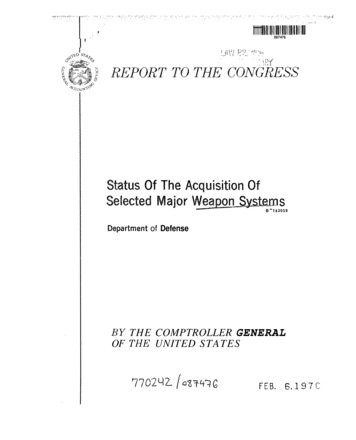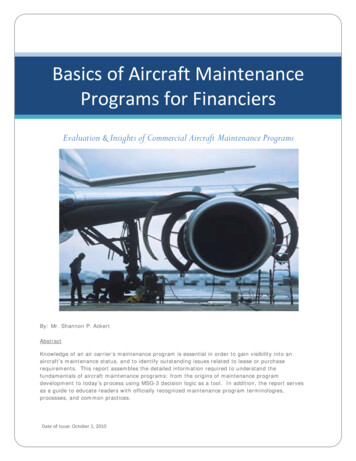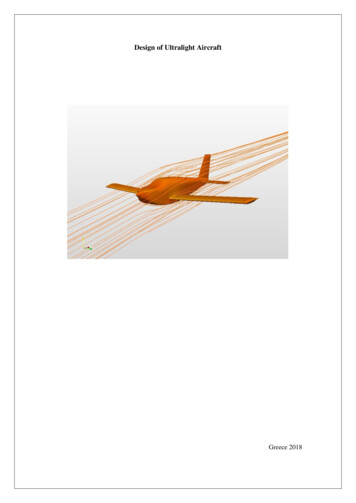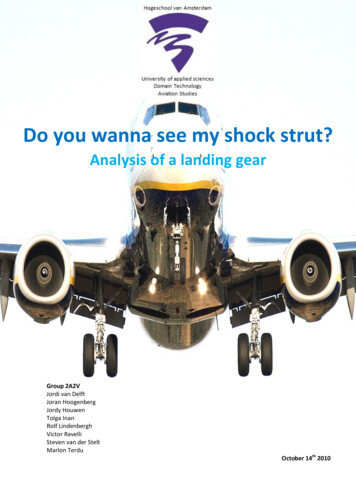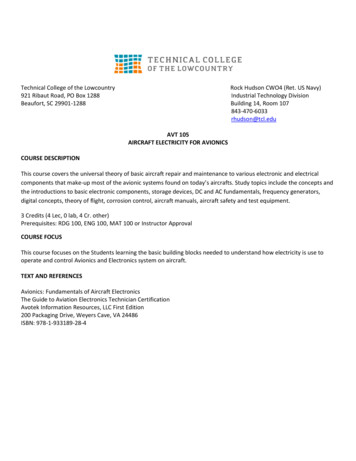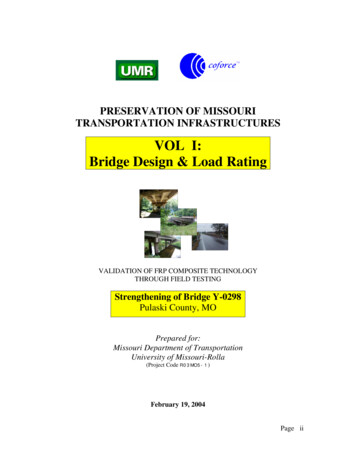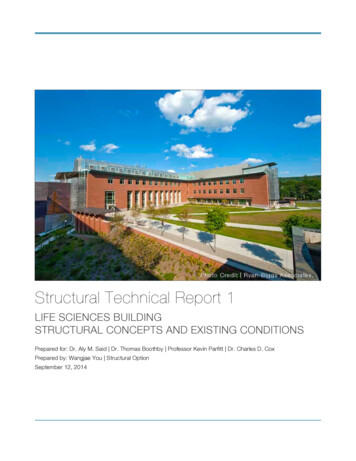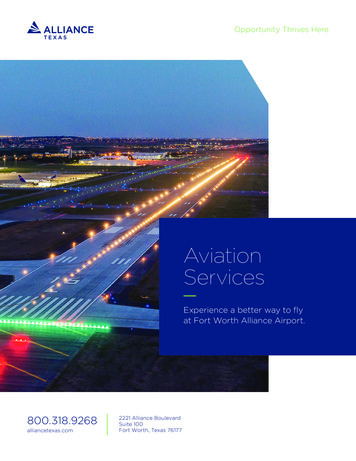
Transcription
LOAD ANALYSIS OF AN AIRCRAFT USING SIMPLIFIED AERODYNAMICAND STRUCTURAL MODELSA THESIS SUBMITTED TOTHE GRADUATE SCHOOL OF NATURAL AND APPLIED SCIENCESOFMIDDLE EAST TECHNICAL UNIVERSITYBYEMRE ÜNAYIN PARTIAL FULLFILLMENT OF THE REQUIREMENTSFORTHE DEGREE OF MASTER OF SCIENCEINAEROSPACE ENGINEERINGFEBRUARY 2015
Approval of the thesis:LOAD ANALYSIS OF AN AIRCRAFT USING SIMPLIFIEDAERODYNAMIC AND STRUCTURAL MODELSsubmitted by EMRE ÜNAY in partial fulfillment of the requirements for the degreeof Master of Science in Aerospace Engineering Department, Middle EastTechnical University by,Prof. Dr. M. Gülbin Dural ÜnverDean, Graduate School of Natural and Applied SciencesProf. Dr. Ozan TekinalpHead of Department, Aerospace EngineeringProf. Dr. Altan KayranSupervisor, Aerospace Engineering Dept., METUExamining Committee MembersProf. Dr. D. Serkan ÖzgenAerospace Engineering Department, METUProf. Dr. Altan KayranAerospace Engineering Department, METUAssoc. Prof. Dr. D. Funda KurtuluşAerospace Engineering Department, METUProf. Dr. Yusuf ÖzyörükAerospace Engineering Department, METUDerya Gürak, M.Sc.Turkish Aerospace Industries, Inc.Date:04.02.2015
I hereby declare that all information in this document has been obtained andpresented in accordance with academic rules and ethical conduct. I alsodeclare that, as required by these rules and conduct, I have fully cited andreferenced all material and results that are not original to this work.Name, Last name: Emre ÜnaySignature:iv
ABSTRACTLOAD ANALYSIS OF AN AIRCRAFT USING SIMPLIFIEDAERODYNAMIC AND STRUCTURAL MODELSÜnay, EmreM.S., Department of Aerospace EngineeringSupervisor: Prof. Dr. Altan KayranFebruary 2015, 120 pagesAircraft must be light enough to fly but also strong enough to endure the loads theyexperience during flight. Designing such a structure is one of the most demandingworks in an aircraft design project. In order to design such a structure, accurateevaluation of loads is important. Once the loads applied to the structure arecalculated precisely, then the deflections and stresses can be calculated and sizingof the structures can be performed accordingly.Therefore, in aircraft design projects, loads group lies at the heart of the designcycle. It receives inputs from various design groups such as aerodynamics group,v
structures group, weight and balance group, systems groups, airworthiness group,and so on. Not only receiving these inputs, but load group also provides outputs tovarious groups, mainly structural design and analysis. Those interactions makeaircraft loads one of the most multidisciplinary subjects in aircraft design andanalysis. On the other hand, because of those interactions with all disciplines of thedesign cycle, load analyses are also quite complex, requires systematic work, abilityto process massive amounts of data, adequate insight of both aerodynamic andstructural issues and communication with not only within the company but also withcertification authorities.The objective of this study is provide a comprehensive overview of load analysisprocess, to develop methods for simplification of aircraft structural andaerodynamic models to make it possible to perform the load analysis in a fast andintegrated way during conceptual and preliminary design phases, then to perform aload analysis of an ultralight aircraft as a case study for the demonstration of theload analysis process.Keywords: aircraft loads, static load analysis, structural analysis, staticaeroelasticityvi
ÖZBİR UÇAĞIN SADELEŞTİRİLMİŞ AERODİNAMİK VE YAPISALMODELLERİNİ KULLANARAK YÜK ANALİZİÜnay, EmreYüksek Lisans, Havacılık ve Uzay Mühendisliği BölümüTez Yöneticisi: Prof. Dr. Altan KayranŞubat 2015, 120 sayfaUçaklar uçabilmek için yeteri kadar hafif olmak, fakat aynı zamanda üzerilerine etkieden yüklere dayanabilecek kadar da sağlam olmak zorundadırlar. Bu koşullarısağlayabilecek bir yapıyı tasarlamak uçak tasarım projelerindeki en emek isteyenişlerden biridir. Böylesine bir yapıyı tasarlamak için yükleri hassas bir şekildehesaplayabilmek önemlidir. Yapıya etki eden yükler hesaplandığında, yapıdakibükülmeler ve gerinimler de hesaplanabilir ve yapısal elemanlar boyutlandırılabilir.vii
Bu sebeplerden dolayı, uçak tasarım projelerinde, uçak yükleri tasarım döngüsününkalbinde yer alır. Aerodinamik grubu, yapısal tasarım ve analiz grubu, ağırlık vedenge grubu, sistem grupları, uçuşa elverişlilik ve sertifikasyon grubu gibi tasarımgruplarından girdiler alır. Sadece girdiler almak değil, aynı zamanda yapısal grububaşta olmak üzere birçok gruba da çıktı sağlar. Bütün bu etkileşimler, uçak yüklerikonusunu uçak tasarımının en çoklu-disiplinli konularından birisi yapmaktadır. Ötetaraftan, uçak tasarım döngüsündeki tüm bu etkileşimleri sebebiyle, yük analizlerigayet karmaşık olmakta; sistematik çalışma, büyük verileri işleme kabiliyeti veaerodinamik ve yapısal konularda geniş bilgi birikimi gerektirmektedir. Ayrıcaanalizler esnasında sadece şirket içi değil sertifikasyon ve uçuşa elverişlilikotoriteleriyle de iletişim içinde olunması gerekmektedir.Bu tez çalışmasının amacı, yük analizi sürecinin geniş bir derlemesini ve tanıtımınıyapmak, yük analizini özellikle kavramsal ve ön tasarım aşamalarında bütünleşik vehızlı bir şekilde yapabilmek için gereken uçak aerodinamik ve yapısal modellerinisadeleştirme yöntemleri geliştirmek ve yük analizi sürecini örneklendirmek adınabir ultralight tipi uçağın yük analizini gerçekleştirmektir.Anahtar Kelimeler: uçak yükleri, statik yük analizi, yapısal analiz, statikaeroelastisite,viii
To Ahmet Emin Ünay and Şerife Ünayix
ACKNOWLEDGEMENTSI would like to thank my supervisor, Prof. Dr. Altan Kayran, who always helped menot only in this thesis work, but also in all aspects of my both academic andprofessional career. His endless patience is appreciated. I also want to thank thechair of the department, Prof. Dr. Ozan Tekinalp, whose tolerant and helpfulattitude made it possible to complete this thesis work.I could not thank enough the people who made me who I am, my former coworkersand superiors from Turkish Aerospace Industries. Among them are Hüseyin Yağcı,Varlık Özerciyes, Yavuz Güleç, Akif Çetintaş, Ömer Onur, Umut Susuz, EvrenSakarya, Özlem Işıkdoğan, Dilek Ünalmış, Engin Kahraman, Abdülkadir Çekiç,Tuğçe Kiper, Göknur Aydoğan, Muvaffak Hasan, Hakan Taşkaya, MustafaAçıkgöz, Muhittin Nami Altuğ, Can Kurgan, Alper Uzunoğlu, Davut Çıkrıkcı,Hakan Kestek, Mustafa Bahtiyar, Kıvanç Ülker, Murat Çetinel, Kağan Çakır, ErtanZaferoğlu, Benan Aylangan and many others that I could not write here due tospace constraints, but I wish I could.If I have something to write anything about aircraft loads, I owe it to my formerleader and mentor, Derya Gürak. As my first leader, she was there to tolerate thecrude and reckless behaviors of a young, inexperienced engineer. I was lucky tohave such visionary leader who always encouraged innovation, and who contributednot only to my thesis work, but also to the company and to the literature aboutaircraft loads.I want to thank specially Dr. Gürsel Erarslanoğlu, the man who was behind theengineering work in aircraft projects in my former workplace and who endured thex
difficulties of those projects. He was the one who believed me most and I havenever shown my gratitude.I do not have an elder brother, but Fatih Mutlu Karadal was the closest person toone. He has an outstanding technical background, loving heart, rational mind, and isthe most capable engineer I have ever met. I not only thank him, but also wish thebest for him.I would like to thank Arda Kandemir and Yiğit Anıl Yücesan, my fellow coworkersand comrades, who endure the worst of me.There exists proportionality between countries’ achievements in aerospacetechnologies and national aviation culture; as seen in Germany of 1930’s, Germanyof today, USA, United Kingdom, etc. I believe Turkey will join among them soon. Iam grateful to Directorate General of Civil Aviation (SHGM) for paving the wayfor the development of light aircraft, general aviation aircraft, etc. via preparation ofcertification specifications for such aircraft.I want to thank the Ministry of Science, Industry and Technology, for their supportthat helped my dreams come true.Special thanks to my parents, Ahmet Emin Ünay and Şerife Ünay whom I dedicatedthis study to. I cannot find any words to thank them enough for their support.Finally, I would like to mention Vecihi Hürkuş, Nuri Demirağ, Selahattin ReşitAlan and other heroes of Turkish aviation history. But, most importantly, I want toexpress my eternal gratitude to Mustafa Kemal Atatürk, whose ideas shall alwaysenlighten my path.xi
xii
TABLE OF CONTENTSABSTRACT . vÖZ . viiACKNOWLEDGEMENTS . xTABLE OF CONTENTS . xiiiLIST OF TABLES . xviLIST OF FIGURES . xviiiLIST OF ABBREVıATIONS . xxiiCHAPTER 1 INTRODUCTION . 11.1 Structural Loads in Aircraft Design Cycle . 11.2 Analysis of Aircraft Loads . 61.2.1 Input for Load Analysis . 61.2.2 Load Cases . 131.2.3 Calculation of Loads . 231.2.4 Output of Load Analysis . 231.3 Effects of Static Aeroelasticity in Load Analysis . 261.3.1 Deflection and Pressure Redistribution . 261.3.2 Divergence Instability . 281.3.3 Flight Mechanics Coupling . 281.4 Aim of the Study . 29xiii
CHAPTER 2 AERODYNAMIC, INERTIAL AND STRUCTURAL MODELLING OF THEAIRCRAFT .312.1 Description and Details of the Aircraft .312.2 Modeling Philosophy .362.3 Aircraft Aerodynamic Model . 362.3.1 Simplification of the Aerodynamic Model . 392.3.2 Verification of the Model. 422.4 Aircraft Mass Model .472.5 Aircraft Structural Model . 55CHAPTER 3 LOAD CASES.613.1 Requirements . 613.2 Configurations and Mass States. 613.3 Airspeeds and Altitudes .643.4 Load Factors . 653.5 Flight Conditions and Maneuvers . 683.5.1 Symmetrical Maneuvers . 683.5.2 Unsymmetrical Maneuvers . 693.6 Ground Conditions .713.7 Load Cases Table .71CHAPTER 4 AIRCRAFT LOADS CALCULATIONS . 73CHAPTER 5 LOADS POST-PROCESSING AND RESULTS . 795.1 Loads and Critical Cases for the Wing .80xiv
5.2 Loads and Critical Cases for the Horizontal Tail . 855.3 Loads and Critical Cases for the Vertical Tail . 875.4 Loads and Critical Cases for the Fuselage . 895.5 Deflection of the Wing under Critical Loads . 915.6 Loads Redistribution . 925.7 Divergence Analysis of the Wing . 93CHAPTER 6 CONCLUSIONS . 976.1 Recommendations of Future Work . 99REFERENCES . 101APPENDIX A CODE FOR INTEGRATION OF CFD RESULTS . 107APPENDIX B COMPLETE LIST OF LOAD CASES . 113APPENDIX C WING LOADS CALCULATION FLOWCHART . 119xv
LIST OF TABLESTable 2-1: Limbach L550 E Engine Specifications [40].33Table 2-2: Aircraft Design Specifications . 34Table 2-3: Aircraft Performance Specifications . 35Table 2-4: Comparison of Aerodynamic Coefficients .38Table 2-5: Weight Breakdown of the Aircraft . 48Table 2-6: Structure and System Mass Distribution at Station Points . 52Table 2-7: Moment of Inertia Calculation of the Wing Section. 57Table 2-8: Sectional Moment of Inertia Values . 58Table 3-1: Aircraft Weights . 62Table 3-2: Mass States . 62Table 3-3: Aircraft Design Airspeeds .65Table 3-4: Symmetrical Design Conditions for the Ultralight Aircraft . 69Table 3-5: Unsymmetrical Flight Conditions for the Ultralight Aircraft .70Table 3-6: A Portion of Load Case Table . 71Table 5-1: Critical Load Cases for the Wing . 82Table 5-2: Critical Cases for the Wing Torsion . 83Table 5-3: Critical Cases for the Horizontal Tail . 87xvi
Table 5-4: Critical Cases for the Vertical Tail . 89Table 5-5: Comparison of Gust and Yawing Cases . 89xvii
LIST OF FIGURESFigure 1-1: Collar Aeroelastic Triangle [4] .3Figure 1-2: Loads Triangle [4] .4Figure 1-3: Interactions of Loads Group in Aircraft Design Organization [8] .5Figure 1-4: Input for Load Analysis .6Figure 1-5: Schrenk's Method [12] .9Figure 1-6: Application of Strain Gauge Bridges on Structure for Flight Loads Measurement [19] .11Figure 1-7: A Sample Mass Distribution along Wing [4] .12Figure 1-8: A Sample Aircraft Beam Model [24] . 13Figure 1-9: Sample Load Case Definition Chart . 14Figure 1-10: An Example of a typical V-A Diagram [4] .16Figure 1-11: V-n Diagram, or Flight Envelope, as defined by CS-23 [30] .17Figure 1-12: A Typical Weight - CG Envelope [3] .18Figure 1-13: Phases of Roll Maneuver [10] . 20Figure 1-14: Phases of Yaw Maneuver [10] . 21Figure 1-15: Landing Conditions according to CS-25 .22Figure 1-16: 1D Loads Envelope with a Reduced Number of Load Cases.24Figure 1-17: 2-D Loads Envelope [32] . 24xviii
Figure 1-18: Altair UAV of NASA. (Photo from NASA) . 26Figure 1-19: Deflection of F/A-18 wing during pull-up maneuver [36] . 27Figure 1-20: Comparison of lift distributions on rigid wing and elastic wing [5] . 27Figure 1-21: Jig shape [37]. 28Figure 1-22: Pitching Moment Derivative for Rigid and Elastic Aircraft [37] . 29Figure 2-1: The aircraft in isometric view . 31Figure 2-2: The aircraft in three-view . 32Figure 2-3: Limbach L550 E . 33Figure 2-4:Structured Aerodynamic Mesh of the Aircraft . 36Figure 2-5: Unstructured Aerodynamic Mesh of the Aircraft . 37Figure 2-6: CFD Solutions of Structured and Unstructured Meshes at AoA 5 . 37Figure 2-7: Comparison of Structured and Unstructured Grid Results . 39Figure 2-8: Comparison of Schrenk Method, Modified Analytical Method and CFD Results, WingTwist 0, AoA 5 deg. . 43Figure 2-9: Comparison of Schrenk Method, Modified Analytical Method and CFD Results, WingTwist 6 deg, AoA 10 deg . 44Figure 2-10: CFD results of the Aircraft with 10 degrees Aileron Deflection . 45Figure 2-11: Comparison of Schrenk Method, Modified Analytical Method and CFD Results,Aileron Deflection 10 deg, AoA 10 deg. 45Figure 2-12: Location of Center of Pressure obtained from CFD and Analytical Methods. . 47Figure 2-13: Structural and System Layout of the Aircraft . 48Figure 2-14: Lumped Mass Points on the Aircraft Structure . 52Figure 2-15: Front Fuselage Mass Distribution. 54xix
Figure 2-16: Wing Mass Distribution .55Figure 2-17: Beam Model Representation of the Aircraft Structural Model .56Figure 2-18: Wing Structural Layout .56Figure 3-1: Aircraft Weight - CG Envelope with Mass States . 63Figure 3-2: V-n Diagram of the Aircraft with Gust Lines at Sea Level . 67Figure 3-3: V-n Diagram of the Aircraft with Gust Lines at 4000 m Altitude .67Figure 4-1: Load Calculation Process of Aerodynamic and Inertial Loads .73Figure 4-2: Integration of Airloads and Inertial Loads along the Aircraft [12] .74Figure 4-3: Loads Distributions along the Wing for LC79 .75Figure 4-4: Shear Diagram along the Wing for LC79 .75Figure 4-5: Bending Moment Diagram along the Wing for LC79. 76Figure 4-6: Static Aeroelastic Analysis as Coupled Aero-Structural Calculations . 77Figure 4-7: Static Aeroelastic Analysis with Simplified Models . 77Figure 5-1: Load Case Colour Map for Loads Envelopes .80Figure 5-2: Wing Load Distribution .81Figure 5-3: Wing Shear Force Distributiom . 81Figure 5-4: Wing Bending Moment .82Figure 5-5: Wing Torsional Moment Distribution . 83Figure 5-6: Wing Bending and Torsional Moment at Wing Root . 84Figure 5-7: Comparison of Wind Bending Moment for Flexible and Rigid Analyses . 85Figure 5-8: Horizontal Tail Load Distribution . 85xx
Figure 5-9: Horizontal Tail Shear Force Distribution . 86Figure 5-10: Horizontal Tail Bending Moment Distribution . 86Figure 5-11: Vertical Tail Load Distribution . 87Figure 5-12: Vertical Tail Shear Force Distribution . 88Figure 5-13: Vertical Tail Bending Moment Distribution . 88Figure 5-14: Fuselage Vertical Shear Force Distribution . 90Figure 5-15: Fuselage Lateral Shear Force Distribution . 90Figure 5-16: Bending Deflection of the Wing Under Critical Load Case . 91Figure 5-17: Torsional Deflection of the Wing Under Critical Load Case . 92Figure 5-18: Comparison of Load Distributions over Flexible and Rigid Wing . 93Figure 5-19: Torsional Deflection of the Wing at Various Airspeeds . 94Figure 5-20: Torsional Deflection and Divergence Speed Comparison at Wing Root . 95Figure 5-21: Torsional Deflection and Divergence Speed Comparison at Different Sections . 95Figure C-1: Flowchart of Wing Loads Calculation . 119xxi
LIST OF ABBREVIATIONSaLift curve slopeAoAAngle of attackbWing reference spancWing chordCX, CY, CZ Aerodynamic force coefficients along body x, y and z axesCL, CM, CN Aerodynamic rolling, pitching and yawing moment coefficientsCPPressure coefficientcl, cLLift coefficientclαLift curve slope, or derivative of lift coefficient w.r.t. angle of attackCFDComputational Fluid DynamicsCSCertification Specifications (European Aviation Safety Agency)DLMDoublet Lattice MethodeOswald efficiency coefficient, or chordwise location of elastic axisEYoung's ModulusEASAEuropean Aviation Safety AgencyEWEmpty WeightFAAFederal Aviation AdministrationFARFederal Aviation RegulationsFX, FY, FZForces in x, y, z directiongGravitational accelerationxxii
GShear ModulusHTHorizontal tailIXX, IYY, IZZInertia in body axes x, y, zJPolar moment of inertiakGust alleviation factorL, M, NRolling, pitching, yawing momentsLCLoad CasemMassMX, MY, MZ Moments around x, y, z axesMLWMaximum Landing WeightMTOWMaximum Take-off WeightMTWMaximum Take-off WeightMZFWMaximum Zero Fuel WeightnLoad factorOEWOperational Empty WeightqDynamic pressureSWing areaSFCSpecific Fuel ConsumptionTTorsionTR-ULTurkish Ultralight Certification SpecificationsULUltralightVA, VADesign Maneuvering SpeedVB, VBDesign Gust SpeedVC, VCCruise Speedxxiii
VD, VDDive SpeedVH, VHMaximum Speed for Level Flight at Continuous PowerVS, VSStall SpeedVLMVortex Lattice MethodVTVertical TailαAngle of AttackβSideslip AngleΔαAngle of attack increment due to sectional twist, or gust conditionλTaper RatioρAir densityxxiv
CHAPTER 1INTRODUCTIONThere exists a motto, which is quoted to famous aircraft designer William BushnellStout: “Simplicate and Add Lightness” [1]. This motto was also used extensively byEd Heinemann, another legendary aircraft designer. It represents the designphilosophy, which implies simplification of design leads to reduction of aircraftweight, which in turn makes avoidance of complex design solutions more possible,hence allowing more simple design and more weight reduction.This thesis work is prepared by the same notion of simplification and weightreduction. However, what essentially being simplified in this study is theaerodynamic and structural model of the aircraft and the methods for load analysis.The ultimate objective, on the other hand, is quite the same: design of a lighterstructure for more efficient aircraft.1.1 Structural Loads in Aircraft Design CycleAircraft are designed to satisfy certain design requirements, just like any othervehicles, or any other machines. Among those design requirements, some of the mostimportant ones are performance requirements, such as range, endurance, maximumspeed, stall speed, take-off distance, landing distance, maximum sustained loadfactor, maximum load factor and payload capacity and so on [2].1
Those performance specifications depend on various parameters based on aircraftgeometry, aerodynamic coefficients and aircraft weight. Among these, aircraftweight is the most critical parameter that affects the performance of the aircraft inevery a
various groups, mainly structural design and analysis. Those interactions make aircraft loads one of the most multidisciplinary subjects in aircraft design and analysis. On the other hand, because of those interactions with all disciplines of the design cycle, load analyses are also quite complex, requires systematic work, ability .
